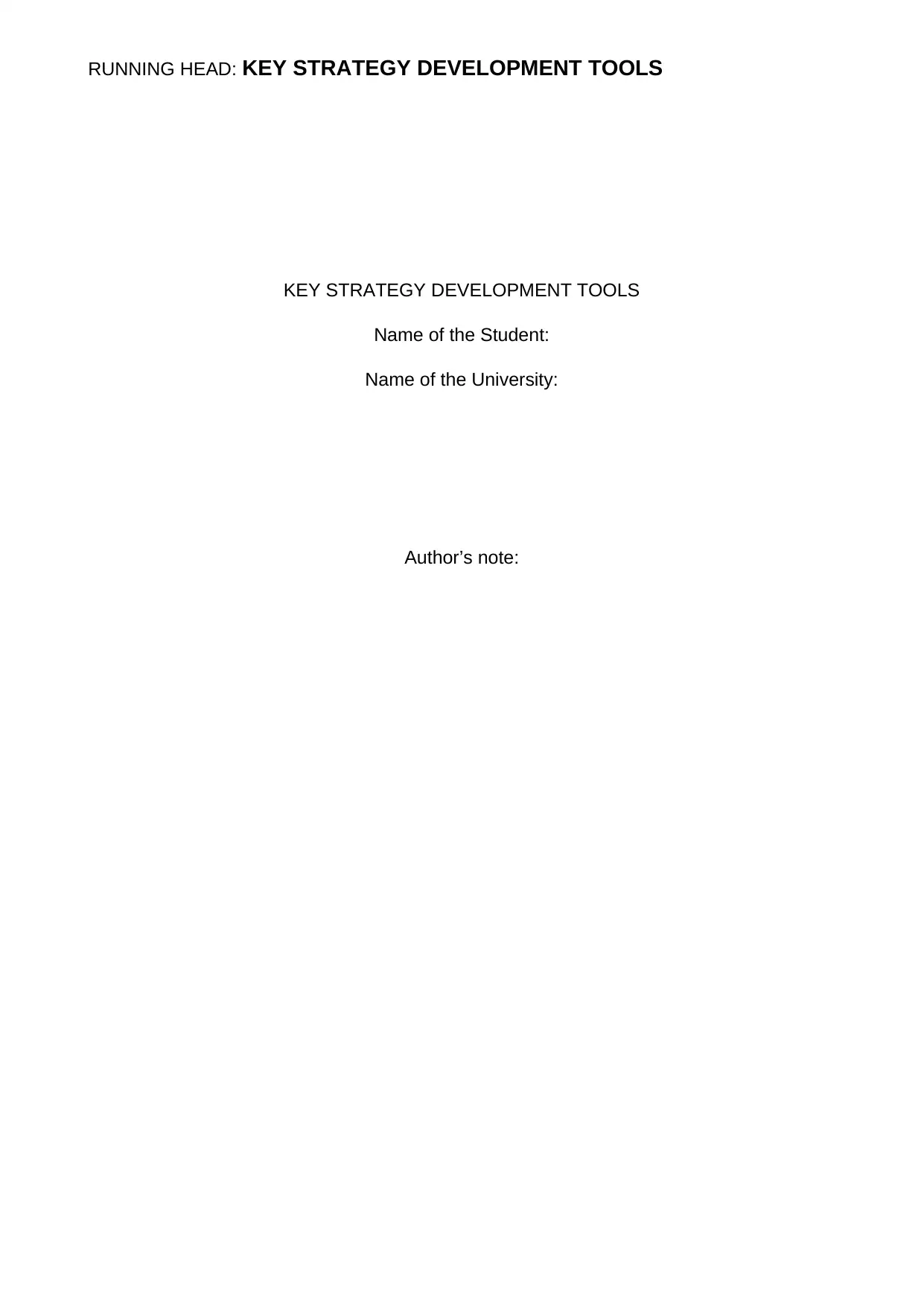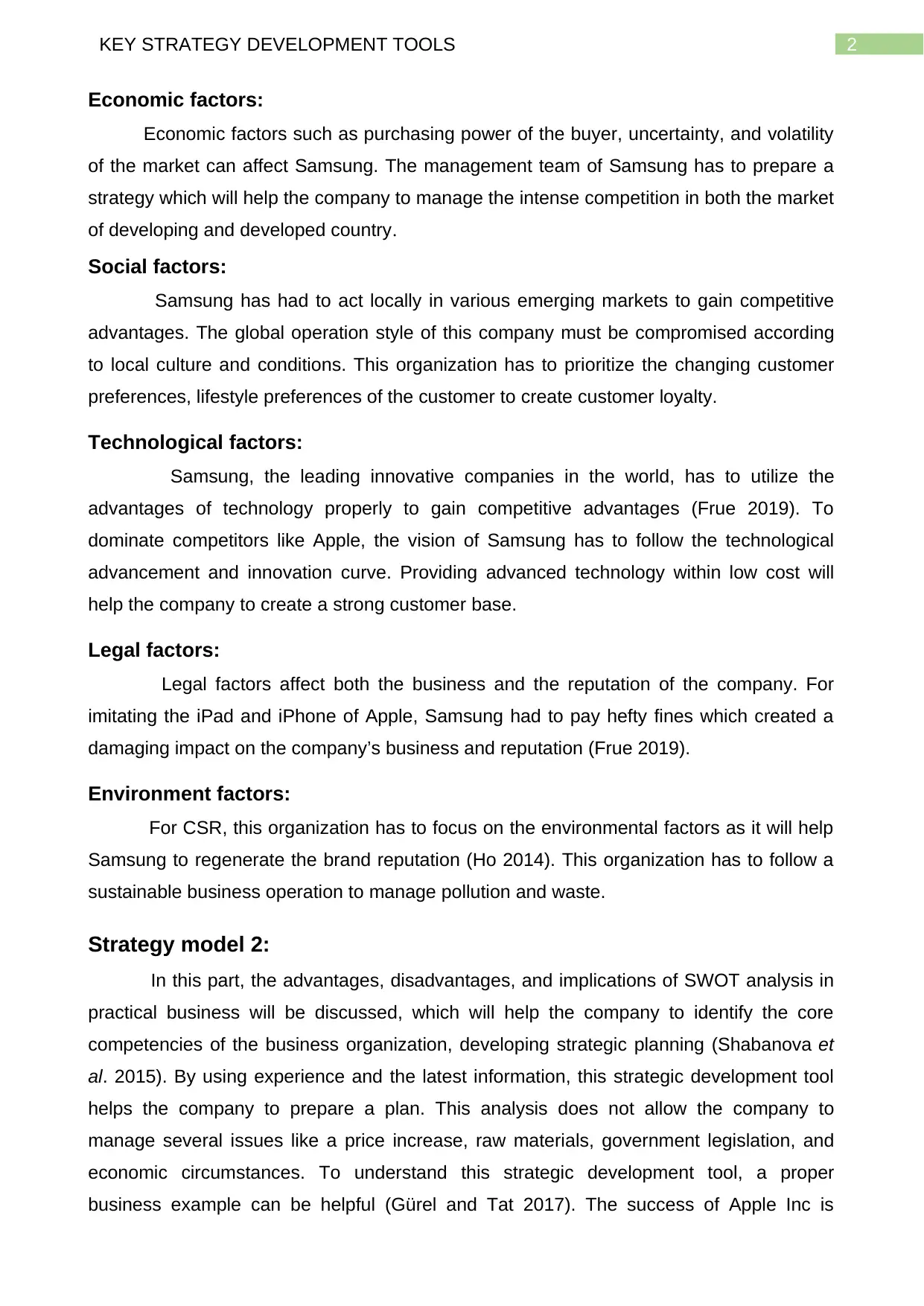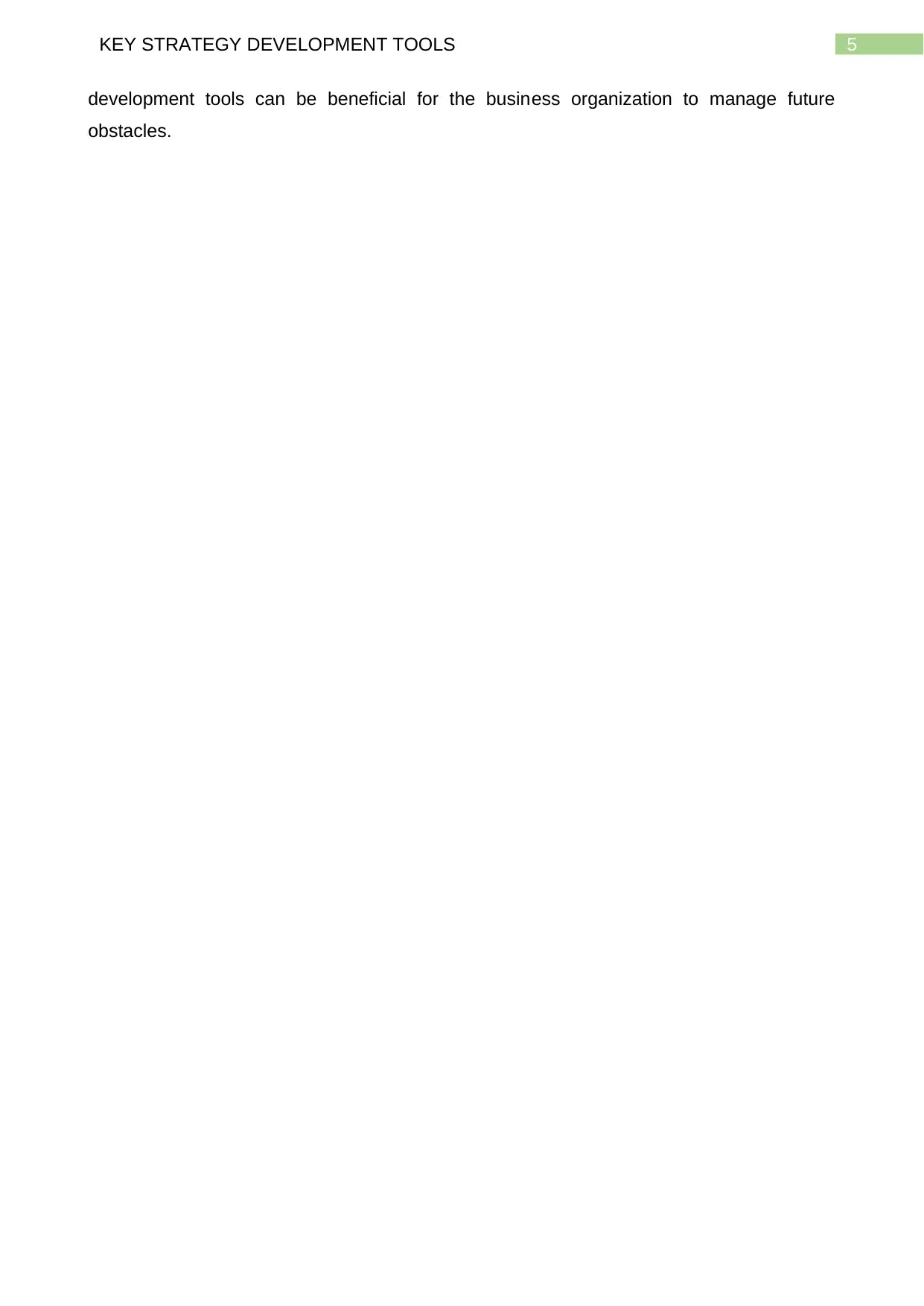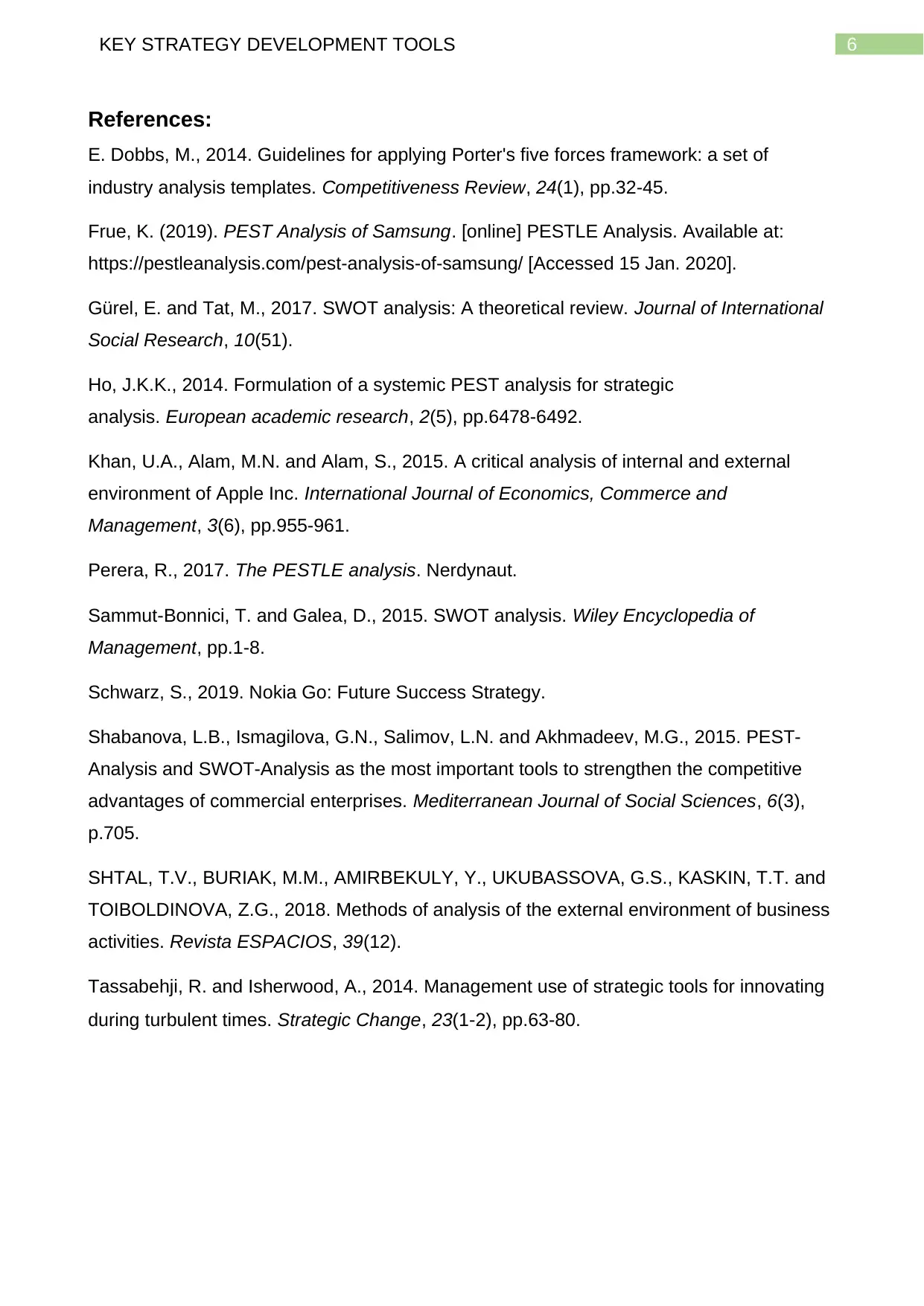Competitive Strategy Essay: Analysis of Strategy Development Tools
VerifiedAdded on 2022/08/24
|7
|1947
|24
Essay
AI Summary
This essay analyzes three key strategy development tools: PESTLE analysis, SWOT analysis, and Porter's Five Forces model. It discusses the advantages, disadvantages, and practical implications of each tool, using real-world business examples to illustrate their application. The essay examines ho...

RUNNING HEAD: KEY STRATEGY DEVELOPMENT TOOLS
KEY STRATEGY DEVELOPMENT TOOLS
Name of the Student:
Name of the University:
Author’s note:
KEY STRATEGY DEVELOPMENT TOOLS
Name of the Student:
Name of the University:
Author’s note:
Paraphrase This Document
Need a fresh take? Get an instant paraphrase of this document with our AI Paraphraser

1KEY STRATEGY DEVELOPMENT TOOLS
Introduction:
The success of a business organization depends on the strategy which drives
decisions in business. It will help the company to identify the strength, weakness,
competitive advantage. To ensure a profitable and sustainable future, decisions, which
drive from an appropriate strategy, can play a significant role in business. In this essay, the
advantages, disadvantages and practical implications of three strategic tools, which are
SWOT analysis, PESTLE analysis, and Porter’s five forces model, will be discussed.
Strategy model 1:
In this part, the advantages of PESTLE analysis and its practical business
implication will be discussed. PESTLE analysis, a strategy development tool, to evaluate
the political, economic, social, technological, legal and environmental factors of the
business (Perera 2017). This strategic planning method provides an understanding of the
wider business environment. The improvement of strategic business analysis is
encouraged by this model. This model can help the business organization to anticipate
future obstacles and take precaution to manage their effects. Appropriate utilization of
business opportunities can be done by using this strategic business tool. A business
organization can gain a competitive advantage by utilizing this model. There are certain
disadvantages of PESTLE analysis. It is difficult to analyze a large amount of data that is
necessary for the analysis. The analysis is based on assumption so it can be said that
proof of this assumption can be unfounded. The society and the market situation has been
continuously changing, so it is challenging to assume future obstacles (SHTAL et
al. 2018). Practical business examples will be helpful to understand the significance of this
strategic business tool. This strategic development tool analyzes several factors that can
influence the business operation in the future.
Political factors:
Political factors can be identified by this analysis, can create both positive and
negative impacts on the business. This analysis will help the management team of the
company to analyze future obstacles and modify the operation style to manage those
obstacles. Samsung, a global business organization, operates in customer appliances and
gadgets. The political environment, political pressure, and political stability are those
political factors that can influence the business of Samsung (Frue 2019).
Introduction:
The success of a business organization depends on the strategy which drives
decisions in business. It will help the company to identify the strength, weakness,
competitive advantage. To ensure a profitable and sustainable future, decisions, which
drive from an appropriate strategy, can play a significant role in business. In this essay, the
advantages, disadvantages and practical implications of three strategic tools, which are
SWOT analysis, PESTLE analysis, and Porter’s five forces model, will be discussed.
Strategy model 1:
In this part, the advantages of PESTLE analysis and its practical business
implication will be discussed. PESTLE analysis, a strategy development tool, to evaluate
the political, economic, social, technological, legal and environmental factors of the
business (Perera 2017). This strategic planning method provides an understanding of the
wider business environment. The improvement of strategic business analysis is
encouraged by this model. This model can help the business organization to anticipate
future obstacles and take precaution to manage their effects. Appropriate utilization of
business opportunities can be done by using this strategic business tool. A business
organization can gain a competitive advantage by utilizing this model. There are certain
disadvantages of PESTLE analysis. It is difficult to analyze a large amount of data that is
necessary for the analysis. The analysis is based on assumption so it can be said that
proof of this assumption can be unfounded. The society and the market situation has been
continuously changing, so it is challenging to assume future obstacles (SHTAL et
al. 2018). Practical business examples will be helpful to understand the significance of this
strategic business tool. This strategic development tool analyzes several factors that can
influence the business operation in the future.
Political factors:
Political factors can be identified by this analysis, can create both positive and
negative impacts on the business. This analysis will help the management team of the
company to analyze future obstacles and modify the operation style to manage those
obstacles. Samsung, a global business organization, operates in customer appliances and
gadgets. The political environment, political pressure, and political stability are those
political factors that can influence the business of Samsung (Frue 2019).

2KEY STRATEGY DEVELOPMENT TOOLS
Economic factors:
Economic factors such as purchasing power of the buyer, uncertainty, and volatility
of the market can affect Samsung. The management team of Samsung has to prepare a
strategy which will help the company to manage the intense competition in both the market
of developing and developed country.
Social factors:
Samsung has had to act locally in various emerging markets to gain competitive
advantages. The global operation style of this company must be compromised according
to local culture and conditions. This organization has to prioritize the changing customer
preferences, lifestyle preferences of the customer to create customer loyalty.
Technological factors:
Samsung, the leading innovative companies in the world, has to utilize the
advantages of technology properly to gain competitive advantages (Frue 2019). To
dominate competitors like Apple, the vision of Samsung has to follow the technological
advancement and innovation curve. Providing advanced technology within low cost will
help the company to create a strong customer base.
Legal factors:
Legal factors affect both the business and the reputation of the company. For
imitating the iPad and iPhone of Apple, Samsung had to pay hefty fines which created a
damaging impact on the company’s business and reputation (Frue 2019).
Environment factors:
For CSR, this organization has to focus on the environmental factors as it will help
Samsung to regenerate the brand reputation (Ho 2014). This organization has to follow a
sustainable business operation to manage pollution and waste.
Strategy model 2:
In this part, the advantages, disadvantages, and implications of SWOT analysis in
practical business will be discussed, which will help the company to identify the core
competencies of the business organization, developing strategic planning (Shabanova et
al. 2015). By using experience and the latest information, this strategic development tool
helps the company to prepare a plan. This analysis does not allow the company to
manage several issues like a price increase, raw materials, government legislation, and
economic circumstances. To understand this strategic development tool, a proper
business example can be helpful (Gürel and Tat 2017). The success of Apple Inc is
Economic factors:
Economic factors such as purchasing power of the buyer, uncertainty, and volatility
of the market can affect Samsung. The management team of Samsung has to prepare a
strategy which will help the company to manage the intense competition in both the market
of developing and developed country.
Social factors:
Samsung has had to act locally in various emerging markets to gain competitive
advantages. The global operation style of this company must be compromised according
to local culture and conditions. This organization has to prioritize the changing customer
preferences, lifestyle preferences of the customer to create customer loyalty.
Technological factors:
Samsung, the leading innovative companies in the world, has to utilize the
advantages of technology properly to gain competitive advantages (Frue 2019). To
dominate competitors like Apple, the vision of Samsung has to follow the technological
advancement and innovation curve. Providing advanced technology within low cost will
help the company to create a strong customer base.
Legal factors:
Legal factors affect both the business and the reputation of the company. For
imitating the iPad and iPhone of Apple, Samsung had to pay hefty fines which created a
damaging impact on the company’s business and reputation (Frue 2019).
Environment factors:
For CSR, this organization has to focus on the environmental factors as it will help
Samsung to regenerate the brand reputation (Ho 2014). This organization has to follow a
sustainable business operation to manage pollution and waste.
Strategy model 2:
In this part, the advantages, disadvantages, and implications of SWOT analysis in
practical business will be discussed, which will help the company to identify the core
competencies of the business organization, developing strategic planning (Shabanova et
al. 2015). By using experience and the latest information, this strategic development tool
helps the company to prepare a plan. This analysis does not allow the company to
manage several issues like a price increase, raw materials, government legislation, and
economic circumstances. To understand this strategic development tool, a proper
business example can be helpful (Gürel and Tat 2017). The success of Apple Inc is
⊘ This is a preview!⊘
Do you want full access?
Subscribe today to unlock all pages.

Trusted by 1+ million students worldwide

3KEY STRATEGY DEVELOPMENT TOOLS
connected to the capability to utilize strengths to manage threats and weaknesses and to
exploit opportunities in the business.
Strength:
This strategic development tool helps Apple Inc to identify its strengths which are
strong customer loyalty, leading innovator in technology, brand reputation, perfect financial
performance, attractive marketing by the talented advertising team. This organization is
focused on dominating other competitors by prioritizing its strengths.
Weaknesses:
SWOT-analysis helps this company to identify its weaknesses which are high price,
decreasing market share, changes in management, patent infringements, and long term
gross margin decline (Sammut‐Bonnici and Galea 2015). To gain competitive advantages,
this organization has to focus on these weaknesses, which are identified by using this
strategic development tool.
Opportunities:
This organization has to exploit its opportunities which are the increase of tablet
and smartphone market, growth of mobile advertising markets, growth of demand for
cloud-based services, the demand of new providers of application processors, manage the
patent issues through acquisitions (Khan, Alam and Alam 2015). Through SWOT analysis,
this organization can identify the opportunities and exploits those opportunities.
Threats:
Increase of taxes, constant technological changes, intense competition with android
os, competition in the online music market, increase of pay levels for the employees are
threats for Apple Inc. It has to manage these threats, identified through SWOT analysis.
Strategy model 3:
Porter’s five forces model, a strategic development tool, is helpful to understand the
forces that shape competition within a business environment. This tool helps the company
to adjust the strategy to suit the competitive environment and increase potential profit (E.
Dobbs 2014). The competition of business is analyzed by this tool. Five components of
this tool will be discussed below with an example.
Threats of new entrants:
Porter’s five forces model can identify the competition in the market for Nokia, a
global business organization. Though this organization had a well-established market, yet
connected to the capability to utilize strengths to manage threats and weaknesses and to
exploit opportunities in the business.
Strength:
This strategic development tool helps Apple Inc to identify its strengths which are
strong customer loyalty, leading innovator in technology, brand reputation, perfect financial
performance, attractive marketing by the talented advertising team. This organization is
focused on dominating other competitors by prioritizing its strengths.
Weaknesses:
SWOT-analysis helps this company to identify its weaknesses which are high price,
decreasing market share, changes in management, patent infringements, and long term
gross margin decline (Sammut‐Bonnici and Galea 2015). To gain competitive advantages,
this organization has to focus on these weaknesses, which are identified by using this
strategic development tool.
Opportunities:
This organization has to exploit its opportunities which are the increase of tablet
and smartphone market, growth of mobile advertising markets, growth of demand for
cloud-based services, the demand of new providers of application processors, manage the
patent issues through acquisitions (Khan, Alam and Alam 2015). Through SWOT analysis,
this organization can identify the opportunities and exploits those opportunities.
Threats:
Increase of taxes, constant technological changes, intense competition with android
os, competition in the online music market, increase of pay levels for the employees are
threats for Apple Inc. It has to manage these threats, identified through SWOT analysis.
Strategy model 3:
Porter’s five forces model, a strategic development tool, is helpful to understand the
forces that shape competition within a business environment. This tool helps the company
to adjust the strategy to suit the competitive environment and increase potential profit (E.
Dobbs 2014). The competition of business is analyzed by this tool. Five components of
this tool will be discussed below with an example.
Threats of new entrants:
Porter’s five forces model can identify the competition in the market for Nokia, a
global business organization. Though this organization had a well-established market, yet
Paraphrase This Document
Need a fresh take? Get an instant paraphrase of this document with our AI Paraphraser

4KEY STRATEGY DEVELOPMENT TOOLS
Nokia is failed to maximize it. Barriers to entry in the market factor are high for this
company as this company failed to hold the market position (Tassabehji and Isherwood
2014). This organization must focus on brand identity, brand switching cost, high expected
retaliation.
Threats of substitutes:
Threats of substitutes are always high for Nokia as there are various competitors
like Apple, Samsung, and Blackberry. This organization has to create brand loyalty and
provide attractive features to the customers. It will help the company to acquire the
market.
Bargaining power of buyers:
The bargaining power of buyers is rising. By using Porter’s five forces model,
several factors are identified that are sensitive price, no direct stores. This organization
has to prepare a strategy to gain competitive advantage ad increase the market share.
Bargaining power of suppliers:
Through the use of Porter’s five forces, it can be said that the suppliers of hardware
are low. On the other hand, the suppliers of software are high. This organization has to
develop a strategy that will help the company to manage the obstacle by focusing on
prioritizing the opportunities.
Rivalry inside the industry:
Porter’s five forces can identify the rivalry inside the market. A business
organization like Nokia can utilize the information regarding the competitive rivalry to
prepare the strategy. The competitive rivalry in the mobile phone market is very high
(Schwarz 2019). The competition in the market is not flexible at all. So it can be said that
to dominate other competitors in the market, the management team of Nokia has to
prepare an appropriate strategy, which will help the company to maximize its market
share.
Conclusion:
The aim of this essay was to analyze strategic development tools and its implication
in practical business. This essay has discussed the advantages and disadvantages of
PESTLE analysis, SWOT analysis, and Porter’s five forces model. The significance of
these three strategic development tools is described through practical business examples.
So, in conclusion, it can be said that to gain a competitive advantage, these three strategic
Nokia is failed to maximize it. Barriers to entry in the market factor are high for this
company as this company failed to hold the market position (Tassabehji and Isherwood
2014). This organization must focus on brand identity, brand switching cost, high expected
retaliation.
Threats of substitutes:
Threats of substitutes are always high for Nokia as there are various competitors
like Apple, Samsung, and Blackberry. This organization has to create brand loyalty and
provide attractive features to the customers. It will help the company to acquire the
market.
Bargaining power of buyers:
The bargaining power of buyers is rising. By using Porter’s five forces model,
several factors are identified that are sensitive price, no direct stores. This organization
has to prepare a strategy to gain competitive advantage ad increase the market share.
Bargaining power of suppliers:
Through the use of Porter’s five forces, it can be said that the suppliers of hardware
are low. On the other hand, the suppliers of software are high. This organization has to
develop a strategy that will help the company to manage the obstacle by focusing on
prioritizing the opportunities.
Rivalry inside the industry:
Porter’s five forces can identify the rivalry inside the market. A business
organization like Nokia can utilize the information regarding the competitive rivalry to
prepare the strategy. The competitive rivalry in the mobile phone market is very high
(Schwarz 2019). The competition in the market is not flexible at all. So it can be said that
to dominate other competitors in the market, the management team of Nokia has to
prepare an appropriate strategy, which will help the company to maximize its market
share.
Conclusion:
The aim of this essay was to analyze strategic development tools and its implication
in practical business. This essay has discussed the advantages and disadvantages of
PESTLE analysis, SWOT analysis, and Porter’s five forces model. The significance of
these three strategic development tools is described through practical business examples.
So, in conclusion, it can be said that to gain a competitive advantage, these three strategic

5KEY STRATEGY DEVELOPMENT TOOLS
development tools can be beneficial for the business organization to manage future
obstacles.
development tools can be beneficial for the business organization to manage future
obstacles.
⊘ This is a preview!⊘
Do you want full access?
Subscribe today to unlock all pages.

Trusted by 1+ million students worldwide

6KEY STRATEGY DEVELOPMENT TOOLS
References:
E. Dobbs, M., 2014. Guidelines for applying Porter's five forces framework: a set of
industry analysis templates. Competitiveness Review, 24(1), pp.32-45.
Frue, K. (2019). PEST Analysis of Samsung. [online] PESTLE Analysis. Available at:
https://pestleanalysis.com/pest-analysis-of-samsung/ [Accessed 15 Jan. 2020].
Gürel, E. and Tat, M., 2017. SWOT analysis: A theoretical review. Journal of International
Social Research, 10(51).
Ho, J.K.K., 2014. Formulation of a systemic PEST analysis for strategic
analysis. European academic research, 2(5), pp.6478-6492.
Khan, U.A., Alam, M.N. and Alam, S., 2015. A critical analysis of internal and external
environment of Apple Inc. International Journal of Economics, Commerce and
Management, 3(6), pp.955-961.
Perera, R., 2017. The PESTLE analysis. Nerdynaut.
Sammut‐Bonnici, T. and Galea, D., 2015. SWOT analysis. Wiley Encyclopedia of
Management, pp.1-8.
Schwarz, S., 2019. Nokia Go: Future Success Strategy.
Shabanova, L.B., Ismagilova, G.N., Salimov, L.N. and Akhmadeev, M.G., 2015. PEST-
Analysis and SWOT-Analysis as the most important tools to strengthen the competitive
advantages of commercial enterprises. Mediterranean Journal of Social Sciences, 6(3),
p.705.
SHTAL, T.V., BURIAK, M.M., AMIRBEKULY, Y., UKUBASSOVA, G.S., KASKIN, T.T. and
TOIBOLDINOVA, Z.G., 2018. Methods of analysis of the external environment of business
activities. Revista ESPACIOS, 39(12).
Tassabehji, R. and Isherwood, A., 2014. Management use of strategic tools for innovating
during turbulent times. Strategic Change, 23(1‐2), pp.63-80.
References:
E. Dobbs, M., 2014. Guidelines for applying Porter's five forces framework: a set of
industry analysis templates. Competitiveness Review, 24(1), pp.32-45.
Frue, K. (2019). PEST Analysis of Samsung. [online] PESTLE Analysis. Available at:
https://pestleanalysis.com/pest-analysis-of-samsung/ [Accessed 15 Jan. 2020].
Gürel, E. and Tat, M., 2017. SWOT analysis: A theoretical review. Journal of International
Social Research, 10(51).
Ho, J.K.K., 2014. Formulation of a systemic PEST analysis for strategic
analysis. European academic research, 2(5), pp.6478-6492.
Khan, U.A., Alam, M.N. and Alam, S., 2015. A critical analysis of internal and external
environment of Apple Inc. International Journal of Economics, Commerce and
Management, 3(6), pp.955-961.
Perera, R., 2017. The PESTLE analysis. Nerdynaut.
Sammut‐Bonnici, T. and Galea, D., 2015. SWOT analysis. Wiley Encyclopedia of
Management, pp.1-8.
Schwarz, S., 2019. Nokia Go: Future Success Strategy.
Shabanova, L.B., Ismagilova, G.N., Salimov, L.N. and Akhmadeev, M.G., 2015. PEST-
Analysis and SWOT-Analysis as the most important tools to strengthen the competitive
advantages of commercial enterprises. Mediterranean Journal of Social Sciences, 6(3),
p.705.
SHTAL, T.V., BURIAK, M.M., AMIRBEKULY, Y., UKUBASSOVA, G.S., KASKIN, T.T. and
TOIBOLDINOVA, Z.G., 2018. Methods of analysis of the external environment of business
activities. Revista ESPACIOS, 39(12).
Tassabehji, R. and Isherwood, A., 2014. Management use of strategic tools for innovating
during turbulent times. Strategic Change, 23(1‐2), pp.63-80.
1 out of 7
Related Documents
Your All-in-One AI-Powered Toolkit for Academic Success.
+13062052269
info@desklib.com
Available 24*7 on WhatsApp / Email
![[object Object]](/_next/static/media/star-bottom.7253800d.svg)
Unlock your academic potential
© 2024 | Zucol Services PVT LTD | All rights reserved.




